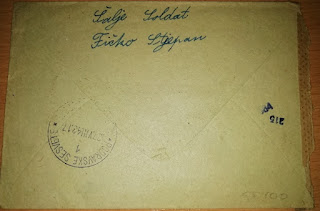Ustasha army - Ustaška vojnica : FELDPOST
Feldpost from Ustasha army is very rare compared to feldpost from Domobranstvo . Ustasha army was much smaller and more heavily involved in fighting hence scarcity of mail . Also I suspect that much of the mail was destroyed after the war to avoid persecution by new Yugoslav communist authorities.
I have seen only packet cards addressed to Ustasha members and official mail, i guess personal mail is extremely rare.
07.12.1942 packet card from Šid to Ustasha member of 4.satnija(company) 29.bojna(battalion) in Srebrenica.
On 01.12.1942 - 29.bojna was part of 1.Stajaći djelatni zdrug. Its Headquater , headquarters company , 3rd and 4th company were stationed in Srebrenica . Average Ustaska Bojna had around 700 members, number varying from 500 to 1000.
24.02.1945. packet card from Vinkovci to member od 5.sat(company) 1.Novačka bojna of 1.Ustaški Obranbeni Zdrug in Vrapče (Zagreb). Official stamp at the back of the card is not clear but i think reads 2.novačka bojna which ic correct as 1.novačka bojna had 1.2.3 and 4. sat. while 5. 6. 7. and 8. sat were in 2.novačka bojna which had 888 members.
02.03.1944 Packet card from Oriolik to a Bojnik (major) of Poglavnikov tjelesni sdrug (PTS). 6.sat ,2.bojna(batallion) 1.pukovnija(regiment) in Varaždin. Official cancel at the back reads 13.sat(stožerna sat) (13.headquaters company), 1.pukovnija PTS. Arrival cancel Varaždin.
13.sat was locted in Varaždin, 2.bojna with 6.sat was located in Novi Marof near Varaždin.
21.01.1944 packet card from Slavonski brod (or Brod n/S as in label) to member of 27.sat!(probably incorrectly written).Novački sklop PTS stationed in Karlovac. (Novački sklop: meaning recruiting(training) unit)
Official cancel reads Novački sklop PTS - 2. (2. probably means - 2.novačka bojna-battalion)
Novački sklop was based in Karlovac , it had :
Headquarter and headquarters sat.
1.novačka bojna with its headquarter and headquarters sat, 1. 2. and 3.novačka sat ,
2.novačka bojna with its headquarter and headquarters sat, 4. 5. and 6. novačka sat.























